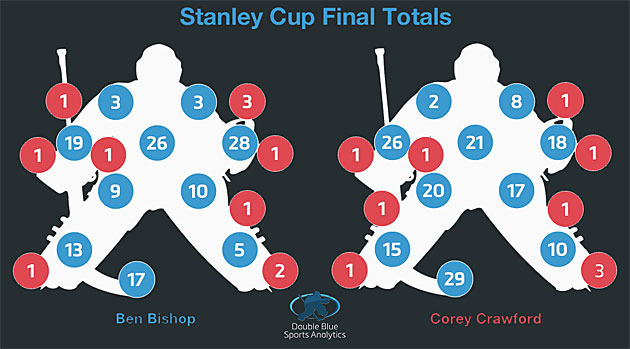Inside The Numbers – Crawford vs Bishop
We knew that goaltending would be a big decider in the finals.
Both Bishop and Crawford had played very well at times. And both had played quite poorly.
There was also the nagging injury that Bishop was facing.
And for all his detractors, Corey Crawford came through when it mattered the most, especially in games five and six.
NHL.com analyzed Game 6 thoroughly and also provided inside into the respective goalies’ finals performance:
Bishop did his best to force a Game 7, making two great saves on lateral power-play chances for Blackhawks forwards Jonathan Toews and Teuvo Teravainen early in the game. Each play crossed the Royal Road, an imaginary line splitting the offensive zone below the top of the faceoff circles. Introduced by former NHL goalie and current MSG analyst Steve Valiquette, the Royal Road identifies tough chances that force a goalie to turn and reset his angle. Bishop faced four Royal Road chances in Game 6, the most in any Cup Final game, including the play that led to an insurance goal by Blackhawks forward Patrick Kane.Crawford stopped the three Royal Road chances he faced in Game 6, including Stamkos’ breakaway move from left to right.
Bishop, who faced 16 shots from inside the home plate area in Game 6, didn’t have much of a chance on Kane’s goal. But he got caught recovering back to his skates on the game-winning goal by Blackhawks defenseman Duncan Keith. Identified as a trend going into the series, Bishop tends to get back to his skates in situations where most goalies will stay on their knees and move laterally with a butterfly push. Whether or not it was related to the torn groin he revealed after the game, the slight delay of getting back up with his left skate after already establishing a push edge with his right skate was costly in his recovery to the left.
See many more statistics and the rest of the story here.



